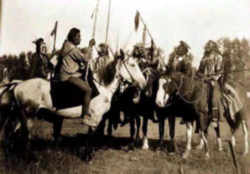


West Virginia Symbols
West Virginia Early History
First Early Inhabitants of West Virginia

Early history examines the archaeological record that tells the story of the first inhabitants of West Virginia. Learn about the prehistory and culture of the first early inhabitants, and what lessons it might teach us about the early history of West Virginia.
West Virginia First Early Inhabitants Timeline
- 11,000 BC - First people in West Virginia were the Paleo-Indians or early hunters.
- 7000BC-1000 BC -
- Differing Archaic cultures developed in the Northern Panhandle, the Eastern Panhandle, and the Kanawha Valley.
- Most of the large game became extinct, and the early hunters either died out or adapted to a culture of hunting small game and gathering edible plants. in 6000 BC
- 1600 BC-1000 BC -
- Adena people differed from the Archaic do to organization of villages
- 1000 BC -Beginning of the Early Woodland or Adena culture.
- 500 BC - 1000 CE - Members of the Hopewell culture began migrating into the Kanawha Valley and erected mounds in the South Charleston and St. Albans area
- 1000 CE - 1600 CE - Native Americans of various tribes occupied West Virginia
- 1000 AD - Woodland Period: homes were established along rivers and trade exchange systems and burial systems were established
- 1614 - Violent confrontation between hundreds of English and Powhatan men on the Pamunkey River, Virginia - refer to Powhatan
- 1622-1624 - The Powhatan Wars, battles and conflicts in Virginia between colonists and American Native Indians
- 1688 - 1763 - The French and Indian Wars between France and Great Britain for lands in North America consisting of King William's War (1688-1699), Queen Anne's War (1702-1713), King George's War (1744 - 1748) and the French and Indian War aka the Seven Years War (1754-1763)
- 1758 - The Anglo-Cherokee War (1758–1761) - The Cherokee uprising in present-day Tennessee, Virginia and the Carolinas
- 1754 - 1763 - The French Indian War is won by Great Britain against the French so ending the series of conflicts known as the
French and Indian Wars
1763 - Treaty of Paris - 1774 - Lord Dunmore's War. Governor Dunmore commanded a force to defeat the Shawnee, Virginia, Pennsylvania and Ohio, down the Ohio River.
Early History of Native Americans in West Virginia
The Indigenous People of West Virginia
The names of the West Virginia tribes included the Cherokee, Iroquois, Manahoac, Meherrin, Monacan, Nottaway, Occaneechi, Saponi and Shawnee.
The first people in West Virginia were the Paleo-Indians, or early hunters, who arrived sometime before 11,000 BC. Excavations in the Kanawha and
Ohio valleys, on Blennerhassett Island, and at Peck's Run in Upshur County have uncovered stone weapons of this period. The early hunters lived in
small family units. Small nomadic groups hunted large game, such as mastodons, mammoths, and buffalo, with spears that had fluted points. Large numbers
of these arrowheads have been discovered along the Ohio River between St. Mary's and Parkersburg. Around 6,000 BC most of the large game became extinct,
and the early hunters either died out or adapted to a culture of hunting small game and gathering edible plants.
Between 7,000 and 1,000 BC, several differing Archaic cultures developed in the Northern Panhandle, the Eastern Panhandle, and the Kanawha Valley.
Excavations have revealed simple tools, primitive pottery, and ceremonial burials. Unlike the nomadic Paleo-Indians, the Archaic people tended to settle
in one place for long periods of time. An archaeological excavation in the late 1960s determined the St. Albans site to be one of the first permanent
settlements in present-day West Virginia. The Archaic people chose this site in order to gather shellfish from the Kanawha River. The use of gardens,
pottery, and ceremonial burial mounds around 1000 BC marked the beginning of the Early Woodland or Adena culture.
The Adena people differed from the Archaic because they organized villages, developed more extensive gardens, wore jewelry, and played games. The most
lasting records of their culture are ceremonial burial mounds. The Adena people were the first Native Americans to build ceremonial mounds. We know
little about how or why the mounds were built, although it may have been that the mounds were built over the remains of honored members of the tribe.
The Hopewell culture apparently developed in the Illinois Valley around 500 BC. As the Hopewell people moved east, their culture had the most significant
impact of any of the early Americans. By the year 1, members of the Hopewell culture began migrating into the Kanawha Valley and erected mounds in
the South Charleston and St. Albans area. During the late prehistoric period (1000--1600), West Virginia was occupied by Native Americans of various
tribes. They lived in small villages and hunted, fished, and cultivated corn, beans, and squash. In addition to many burial sites and petroglyphs (drawings
on stone), one of the largest excavations of a Native American village is Buffalo Village at Buffalo, Putnam County.
By 1600, organized tribes such as the Delaware and Shawnee had moved into present-day West Virginia. In addition, the powerful Iroquois Confederacy
began exerting its influence on the region. The Confederacy was an alliance of five Iroquois-speaking nations - Mohawk, Oneida, Onondaga, Cayuga, and
Seneca - formed in present-day New York in the late 1500s. In 1722, the Tuscaroras joined the Iroquois Confederacy, which became known as the Six Nations.
As the Confederacy fought smaller tribes for control of western Virginia, European colonists set their own designs on the Ohio Valley. Both the British
and French claimed territory comprising present-day West Virginia and Native Americans were forced west. Many of the tribes were destroyed by constant
warfare and European diseases. At the same time, trade with the Europeans proved a strong attraction, enabling the Indians to acquire valuable new
products, such as guns, steel hatchets, cloth, and kettles. The fur trade in particular made many tribes powerful and more aggressive. The Indian nations
successfully played one European power against another. For instance, the British formed an alliance with the Iroquois Confederacy to cut the French
out of the lucrative fur trade. However, the Six Nations also negotiated treaties and traded with the French. In the end, however, the Native American
tribes were almost universally forced from their lands to areas further west.





